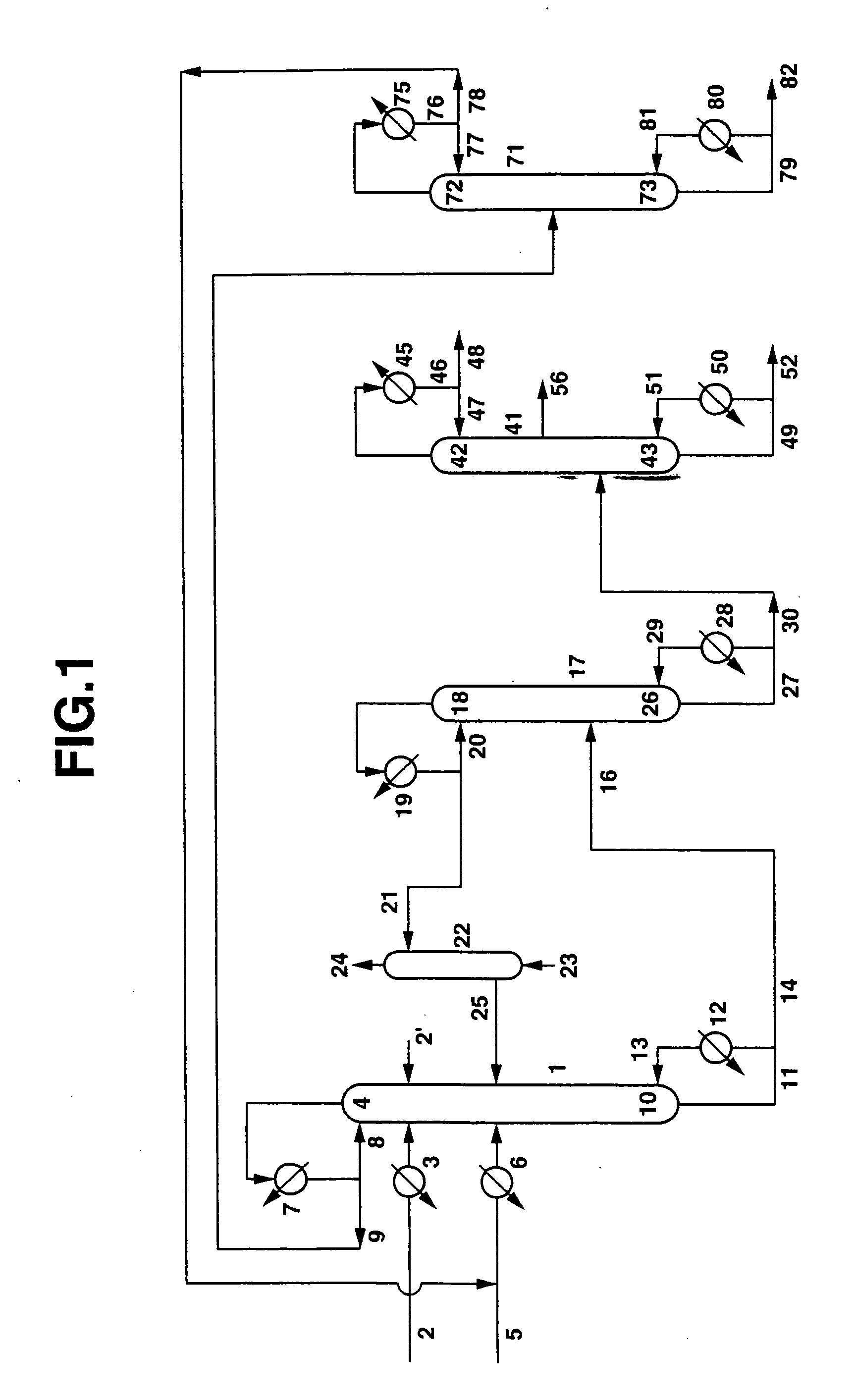Process for production of dialkyl carbonate and diol
a dialkyl carbonate and diol technology, applied in the direction of oxygen compound purification/separation, organic chemistry, chemistry apparatus and processes, etc., can solve problems such as complex processes, and achieve the effect of low aldehyde content and high uv transmittan
- Summary
- Abstract
- Description
- Claims
- Application Information
AI Technical Summary
Benefits of technology
Problems solved by technology
Method used
Image
Examples
example 1
[0101]Dimethyl carbonate (DMC) and ethylene glycol (EG) were produced continuously from ethylene carbonate (EC) and methanol (MeOH) using the apparatus shown in FIG. 1. EC was continuously fed in a liquid form from a conduit 2 via a preheater 3 at a flow rate of 200 g / h into the 3rd stage of a continuous multi-stage distillation column 1 comprising an Oldershow distillation column having an inside diameter 4 cm and 40 stages, an ethylene glycol solution of 18% by weight of potassium hydroxide (KOH) (homogeneous catalyst) was continuously fed in a liquid form also into the 3rd stage via a conduit 2′ at a flow rate of 0.95 g / h, and a mixture of MeOH and DMC (weight ratio: MeOH / DMC=97 / 3) was continuously fed in a liquid form into the 20th stage of the continuous multi-stage distillation column 1 from a conduit 5 via a preheater 6 at a flow rate of 636.4 g / h. The pressure at the top of the continuous multi-stage distillation column 1 was atmospheric pressure, and the temperature at the ...
example 2
[0112]DMC and EG were produced according to the same process as in Example 1, except that as the catalyst, instead of the homogeneous catalyst comprising an ethylene glycol solution of potassium hydroxide, there was used an anion exchange resin having quaternary ammonium groups as exchange groups (obtained by subjecting a Dowex MSA-1 Cl type to ion exchange with a 2N Na2CO3 aqueous solution, repeatedly washing with pure water, and then repeatedly washing with dry methanol, so as to carry out dehydration / drying, approximately 50% of the Cl− ions being exchanged to CO32− ions), which was fixed to the 3rd to 40th stages of the tray portion (each approximately 5 vol % of the liquid residing portion) and the column bottom portion (approximately 10 vol % of the liquid residing portion) such as not to flow out. Here, the temperatures in the column were T1=80.4° C. and T2=98° C., and the average residence times of the reaction liquids were θ1=2.2 hours and θ2=3.8 hours, the total average re...
example 3
[0120]DMC and EG were produced according to the same process as in Example 1, except that the continuous multi-stage distillation column 1 was made to be an Oldershow distillation column having an inside diameter 4 cm and 80 stages, and the stage into which the EC and the catalyst were fed was made to be the 5th stage, while the stage into which the mixture of MeOH and DMC was fed was made to be the 40th stage. Here, the temperatures in the column were T1 (42nd stage)=80.8° C. and T2=98° C., and the average residence times of the reaction liquids were θ1=5.0 hours and θ2=11.2 hours, the total average residence time being 16.2 hours. From these values, α+1.24β=4126. The EC conversion for the transesterification reaction was 99.95%, the DMC selectivity was 99.8%, and the EG selectivity was 99.8%.
[0121]Moreover, the amount of other organic components in the liquid EG withdrawn from the side-cut outlet of the EG purifying column according to gas chromatography was 2 ppm, the aldehyde co...
PUM
| Property | Measurement | Unit |
|---|---|---|
| boiling point | aaaaa | aaaaa |
| residence time | aaaaa | aaaaa |
| temperature | aaaaa | aaaaa |
Abstract
Description
Claims
Application Information
 Login to View More
Login to View More - R&D
- Intellectual Property
- Life Sciences
- Materials
- Tech Scout
- Unparalleled Data Quality
- Higher Quality Content
- 60% Fewer Hallucinations
Browse by: Latest US Patents, China's latest patents, Technical Efficacy Thesaurus, Application Domain, Technology Topic, Popular Technical Reports.
© 2025 PatSnap. All rights reserved.Legal|Privacy policy|Modern Slavery Act Transparency Statement|Sitemap|About US| Contact US: help@patsnap.com



